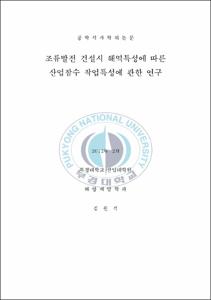조류발전 건설시 해역특성에 따른 산업잠수 작업특성에 관한 연구
- Alternative Title
- A Study of Commercial Diving Work Characteristics with Coastal Conditions for the Construction of Tidal Current Power
- Abstract
- Many countries has been trying to developed eco-friendly renewable energy as like wind, solar heat, geothermal heat, tidal power, tidal current power, and wave power. In particular, marine energies are various and powerful, but It is so hard to work underwater construction. Therefore commercial diving work is very important to install various deep structures. Construction of tidal current power is one of the first step to commercialize eco-friendly renewable energy about tidal current in Korea. Especially, Jangjuk channel is famous as proper area to generate tidal current energy. No one is studied about characteristics of commercial diving works with construction of tidal current generation. Also, No one is compared between commercial diving and coastal environmental conditions. In consequence, the purpose of this study is to introduce commercial diving with work types for construction of tidal current generation and investigate diving working under the conditions, which are working only 40 minutes at slack tide during the neap tide, using the difference of tide level and the time between construction site in Jangjuk channel and tidal station in Jin-do.
Main results obtained are summarized as follows by the step of study:
1) Work types are five to install tidal current generation on Jangjuk channel. Each work types are mooring installation, OMAS(Offshore Maintenance Access System), support structure installation, cable installation and turbine installation.
2) Entire diving working times are 110th during 18 months, majority of diving work out of it is turbine installation about 43.6%. cable installation, mooring installation and support structure construction are 27.3 %, 15.5 %, 13.6 %, respectively.
3) The results from the difference of tide level and the time are that maximum level difference are 0.682 m and maximum and averaged time difference are respectively 215 minutes and about 1∼2 hours between construction site in Jangjuk channel and tidal station in Jin-do. As a result, Planned period of the construction
4) Entire construction period took 18 months and was over 4 times more than planned schedule(4 months). Extended construction periods is due to insufficiency of researching coastal environmental conditions as like tidal current on the construction site and understanding commercial diving.
In order to determine economical construction period of tidal current power generation, it is necessary to examine accurate coastal environmental conditions and take plenty of time to discuss work types of commercial diving with all those, especially in southwest of Korea.
- Issued Date
- 2012
- Awarded Date
- 2012. 2
- Type
- Dissertation
- Publisher
- 부경대학교 산업대학원
- Alternative Author(s)
- Kim WonSeok
- Affiliation
- 부경대학교
- Department
- 산업대학원 해양개발학과
- Advisor
- 류청로
- Table Of Contents
- 1. 서론 1
1.1 연구배경 1
1.2 연구목적 3
2. 진도 장죽수로 조류발전 건설시 적용된 산업잠수 4
2.1 잠수의 분류 4
2.1.1 환경압 잠수 4
2.1.2 대기압 잠수 13
2.2 투입된 산업잠수 장비 15
2.3 현장에서 사용된 잠수 감압표 20
3. 장죽수로 조류발전 시공 현황 및 작업 소개 27
3.1 우리나라의 조류발전 현황 27
3.2 진도 장죽수로 조류발전 설치공사 개요 28
3.2.1 공사 개요 28
3.2.2 조류발전 설치 세부공종 29
3.3 장죽수로 주변의 해양물리환경 특성 36
3.4 조류발전 현장의 잠수 작업 환경 및 공종별 잠수 내용 43
4. 조류발전 잠수공정 설계를 위한 잠수작업특성 분석 45
4.1 공정별 잠수작업 투입시간 특성 분석 45
4.1.1 공정별 소요기간 및 잠수 횟수 45
4.1.2 해역특성과 잠수작업의 비교 및 분석 48
4.2 잠수작업 영향인자에 따른 각 공정별 작업 지연 분석 60
4.2.1 잠수작업에 영향을 주는 인자 60
4.2.2 각 공정별 작업 지연 분석 61
5. 요약 및 결론 65
참고문헌 68
부 록 69
- Degree
- Master
- Files in This Item:
-
-
Download
 조류발전 건설시 해역특성에 따른 산업잠수 작업특성에 관한 연구.pdf
기타 데이터 / 11.92 MB / Adobe PDF
조류발전 건설시 해역특성에 따른 산업잠수 작업특성에 관한 연구.pdf
기타 데이터 / 11.92 MB / Adobe PDF
-
Items in Repository are protected by copyright, with all rights reserved, unless otherwise indicated.